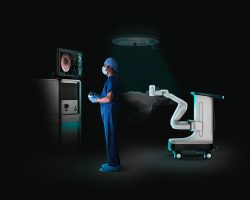Clueless SEAS Bwogger Skylar Li tries to understand cutting-edge nanomedicine research, nanocrystal TV screens, and who exactly Raman is.
Nanotechnology: from Single-Molecule Raman Spectroscopy to Image-Guided Cancer Surgery – the name does justice in describing precisely what Professor Shuming Nie, Distinguished Chair in Bioengineering at the University of Illinois at Urbana-Campaign, gave his talk on last Thursday: spectroscopy and image-guided cancer surgery. We don’t do click-baits in science! If the word “spectroscopy” gives you a light migraine – don’t try saying it five times in a row because I nearly pulled a face muscle – it’s the analysis of an object’s component lights (i.e. energies) to investigate its properties. The gist is that every element has a unique internal structure, so when their electrons absorb a certain amount of energy, they spit the same energy back out again in the form of photons. The set of the photon’s possible wavelengths are called spectra, an element’s unique atomic “fingerprint”. Spectroscopists like Professor Shuming Nie are interested in advancing their analysis of spectra so that we can attain information about the structure and properties at smaller scales.
With a cup of coffee in hand and a plentiful of jokes, Professor Nie described the trajectory of his research, starting from the groundbreaking findings that made him a pioneer in his field: surface-enhanced Raman spectroscopy. No, we’re not dissecting our favorite 2 a.m. noodle dish – it’s a technique that attains the intensity and wavelength of photons by scattering lights by aiming a high-intensity laser. Prof Nie’s research, which has been published in Nature and cited 10,116 times as of now, uses a revolutionary technique that probes single molecules and nanoparticles by enhancing the scattering of lights. By absorbing singular molecules with silver nanoparticles, the efficiency of Raman scattering was improved by 10^15-fold. I thought it was pretty courageous of him to publish the results, considering how surprising and unprecedented they were.
The latter half of the talk was about the technique’s applications, which is just the best thing about engineering *coughs in SEAS*. Since gold nanoparticles are detectable through the skin without any contact, they can be used as tags to find cellular cancer biomarkers. The sensitivity of Raman spectroscopy can also help to find residue tumors on the margins between the tissue and tumor, which is very effective in preventing a recurrence. The lucky audience got to see many photos of resected liver tumors from Professor Nie’s collaborations with surgeons at Emory University and Mount Sinai, which didn’t make me want to reevaluate my dinner at all.
In the future, Professor Nie envisions the convergence of imaging tracers, multispectral sensors, robotics, AR, and AI – so basically, the creepy Hecatoncheires-style operating table from Jennifer Lawrence’s Passenger movie. He talked about a company named Auris Health that developed a surgical robot with a remote resembling an Xbox controller, which has already been FDA approved and acquired by Johnson & Johnson for $3.4 billion. I don’t know how I’d feel about my surgeons sliding a camera into my body with accelerometers, but at least binge-playing Assassin’s Creed counts as a pre-med extracurricular now.
 some dystopian tumor removal!
some dystopian tumor removal!
The talk ended with a quick review of some of Professor Nie’s current projects, including developing quantum dot displays for high-resolution 4KTV screens. “Quantum dot” is just a fun name for nanocrystal semiconductors, which are tiny light-emitting particles that can be used to composite subpixels. In summary, the Prof flexed for five minutes about how the films his lab developed are double the brightness of Samsung’s because of their high quantum yield (photons emitted per photons absorbed). Spectroscopy, nanomedicine, and now TV manufacturing – what can’t Professor Nie do?
image via TechCrunch


 0 Comments
0 Comments